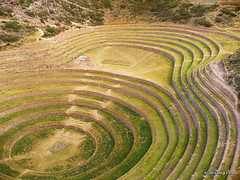Could the Nazcans fly?
It is a mystery as yet unsolved. How were the ancient Nazca able to draw such huge and complicated designs in the barren Nazca plains, drawings so large that they are only visible from the air? Could it be that this pre-Inca civilisation mastered some form of flight allowing them to both create and appreciate their work? Some think so.
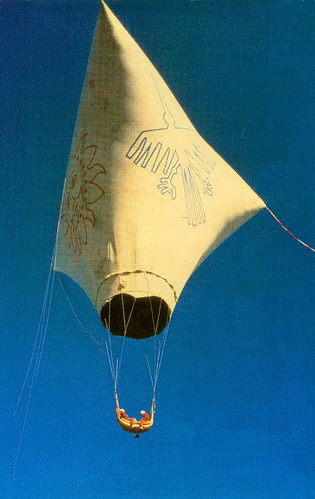
Condor I
One of the first groups to propose that the Nazcans had mastered flight was the International Explorers Society in the 1970s. It seemed technically impossible to them that the famous shapes of the monkey, hummingbird and spider, among others, could ever have been drawn accurately without leaving the ground. There is no need to go as high as a light aeroplane, as Maria Reiche showed when she built a short 13m high tower that allows you to just make out 3 shapes. The Nazcans would only need to lift themselves off the ground by only a few times that.
Based on the exceptional quality of the textiles the Nazca people created, the group proposed that it could feasibly be used as the envelope of a simple hot-air balloon. Named Condor 1, their 26m high test balloon made with similar materials managed to make it to 183m before falling back to the ground with its two pilots then being whisked up again to 366m.
At the heart of this attempt were Jim Woodman, who had long proposed Nazcan flight, and Julian Nott a design engineer and balloonist. All involved were convinced that they had proven that it was at least a possibility that the ancient line builders could have flown.
Nott later said, “Would [the lines] have been made if no one could see them? Would da Vinci have painted the Mona Lisa if he could not step back and admire the finished canvas?”
In 2002 Nott repeated this earlier success, creating a new balloon using only materials and techniques available in ancient times. He comments that the cotton fabric used in burials and found across the area are adequate for constructing a balloon.
Nott writes;
As you can easily understand, this project was intriguing to many balloonists and I was able to get wonderful people to participate. Peter Cuneo and Barbara Fricke came to Nazca and I was lucky enough to have Peter fly with me. Having designed the balloon, I approached Best Aviation to build it. In Peru they organized the layout of the balloon with skill: it was not easy to manage 600 pounds of cotton fabric.
A lot of care went into the choice of fabric. It had to be something the Nazca people could have woven. This was easy since their skills far exceeded what was needed for this balloon. But it had to have adequate tensile and tear strength while being light.
When people see photographs of the balloon the general reaction is that it was very dangerous. But in fact
Bert and I did a long series of tests to ensure the attachments were safe. Low porosity was of particular importance and this is a fascinating subject. When we built the first prehistoric balloon it was so porous I feared it might not fly at all. But inflating it over a fire and exposing it to suitable smoke for a long period, soot particles filled up the fabric.Beyond the balloon and a fire the only other component of this starkly simple craft was the gondola. The classic reed boat, known in Peru and Bolivia as the “Balsa“, has been made since ancient times. The gondola was made by hand on one of the “Floating Islands” in Lake Titicaca. Twelve and a half thousand feet up in the Andes, the islands are a very unlikely workshop!
The flight proved to be another success, and those who believe the Nazca civilisation had the ability to fly cite this as evidence.
Others aren’t so sure. Katherine Reece is one such person.
Quoting from Jim Woodman’s book;
I know damned well someone flew at Nazca,” I kept insisting. “You simply can’t see anything from ground level. You can’t appreciate any of it from anywhere except from above. You can’t tell me the Nazca builders would have gone to the monumental efforts they did without ever being able to see it.
Reece responds;
With this modern, and incorrect, viewpoint in mind Woodman attempted to prove that the Nasca could have flown. To do so, he gathered information and constructed a hot-air smoke balloon using material available to the ancient Nasca people. While the lift for the balloon was provided by hot air the porous material was “sealed” by the smoke and soot from the fire. In this fashion a very short manned flight of approximately two minutes was successful.
She then derides him for coming to the conclusion that the Nazcans must have flown, and that this can be proven by archaeology. She complains that “Woodman did not reference his sources, provide detailed information, or images depicting his visual evidence that could be analyzed”. Woodman, for example, declared that a piece of pottery with an image that looks remarkably like a modern day hot air balloon was all but firm evidence that balloons existed. Reece, however, shows pretty clearly that it is just a bean.
Perhaps the most damning criticism;
When Woodman flew his balloon at Nasca he inflated the envelope by digging a pit, filling it with wood, and feeding the hot air and smoke into the balloon via a tunnel. Woodman claims that such burn pits with “charred rocks” are present however no evidence of any fires large enough to inflate a balloon have been found at Nasca. Markus Reindel, of the Organisation des Deutschen Archäologischen Instituts, has excavated what Woodman calls “burn pits” and discovered that they are in fact small shrines where offerings were made that have helped illuminate the purpose of the lines.
It seems unlikely that the Nazcans used balloons to design and admire their huge shapes, but Woodman and Notts have proven that they could have if their imaginations had stretched that far.
As for designing such huge shapes in the desert that no Nazcan other than the Nazcan gods could appreciate, I’d have to disagree with Notts and Woodman. Stranger and more devoted things have been done in the name of religion.
Tags: nazca culture, nazca lines



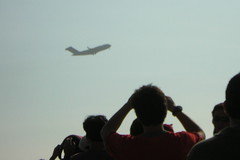

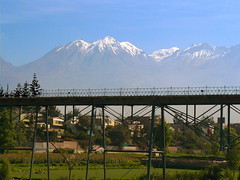

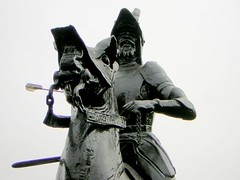
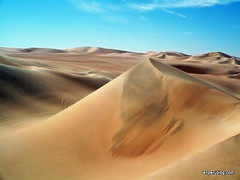
![Peru’s patent win strikes blow against biopiracy [Featured]](http://farm4.static.flickr.com/3213/3119559648_54f3119415.jpg?v=0)
